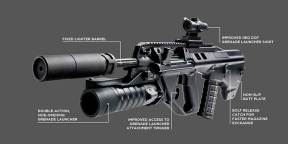COMPACT FIREPOWER
PHOTO // Copyright of Thales Australia
At 3.25kg, it is one of the lightest assault rifles in the market. Not only does this make it more user-friendly, its design also increases the hit rate. The latest asset of the Australian Defence Force (ADF), the F90 Assault Rifle provides a clear advantage when used in close-quarter combat.
An upgrade from its predecessor, the Austeyr F88, the F90 was developed by Thales Australia to meet the requirements of the modern-day soldier. At 4.8kg, the F88 was significantly heavier and had been used by the ADF since 1998.
Lighter, easier and faster
Similar to the F88, the F90 can be fitted with the M203 grenade launcher through a simple attachment. However, the newer gun is 1.36kg lighter even when both weapons are fully fitted with their grenade launchers.
Thales Australia Armaments Vice-President Kevin Wall said: "Our soldiers deserve the best possible equipment and the F90 delivers on all counts.
"Enhancing the Austeyr is the most cost-effective way to deliver a capability upgrade, and we've worked closely with defence and army units to design, test and manufacture this world-class weapon."
Featuring a bullpup design, the F90 allows for a shorter overall weapon for a given barrel length. With the magazine located behind the trigger, such a design allows the bullet to travel faster and with greater accuracy because of its longer barrel length. This also improves the rifle's manoeuvrability and reduces its weight.
A similar design is found in the Singapore Assault Rifle 21, which proves to be a huge advantage in urban combat as the use of long rifles is limited by confined spaces.
Thales Australia Chief Executive Officer Chris Jenkins said: "The F90 is a weapon ideally suited to the modern battlefield. Light, compact and adaptable, it offers armed forces a cost-effective upgrade with a substantial degree of future-proofing."
While working on the enhancements, Thales Australia also increased the reliability and general handling of the rifle. These were done through a redesigned butt-stock with a ribbed polymer buttplate for improved shoulder grip, a lengthened top rail, and the inclusion of a case deflector next to the ejection port so that the weapon can be fired from the left shoulder.
Other improvements include the introduction of a bolt release catch and the red dot grenade launcher sight. The former allows magazine changes to be done faster, while the latter reduces the time taken to execute a grenade firing and helps soldiers to hit their targets more accurately.
Used by the ADF, the F90 is light, accurate and more user friendly than its predecessor.
A hit with soldiers
To mark its significant enhancements, the F90 will be known as the Enhanced F88 (EF88) within the ADF. The first batch was issued to the 1st Battalion, Royal Australian Regiment (1 RAR) for trials in June this year and they were a hit with the soldiers. Results showed that they considered the EF88 to be remarkably modular, balanced and accurate during combat and longer range shooting.
Private Jake Whitlock of 1 RAR, who was involved in a trial of the EF88, said: "The EF88 impressed everyone with its accuracy, reliability and design."
There are already plans for 1 RAR to use the EF88 during upcoming Support Company courses, jungle training and exercises.
Thales Australia was awarded AUD 100 million ($100.3 million) by the Australian Department of Defence to produce and deliver 30,000 F90s to the ADF.
The weapons issued will have two variants: a 20-inch barrel rifle and a carbine version. These are the F90M and F90 products from Thales' range, which also includes versions with grenade launchers. Deliveries have already begun and will be done in phases over six years.
| Tech Specs | ||
| F90M | Calibre: 5.56mm Weight: 3.39kg Barrel length: 508mm Overall length: 802mm | |
| F90 | Calibre: 5.56mm Weight: 3.25kg Barrel length: 407mm Overall length: 700mm | |










